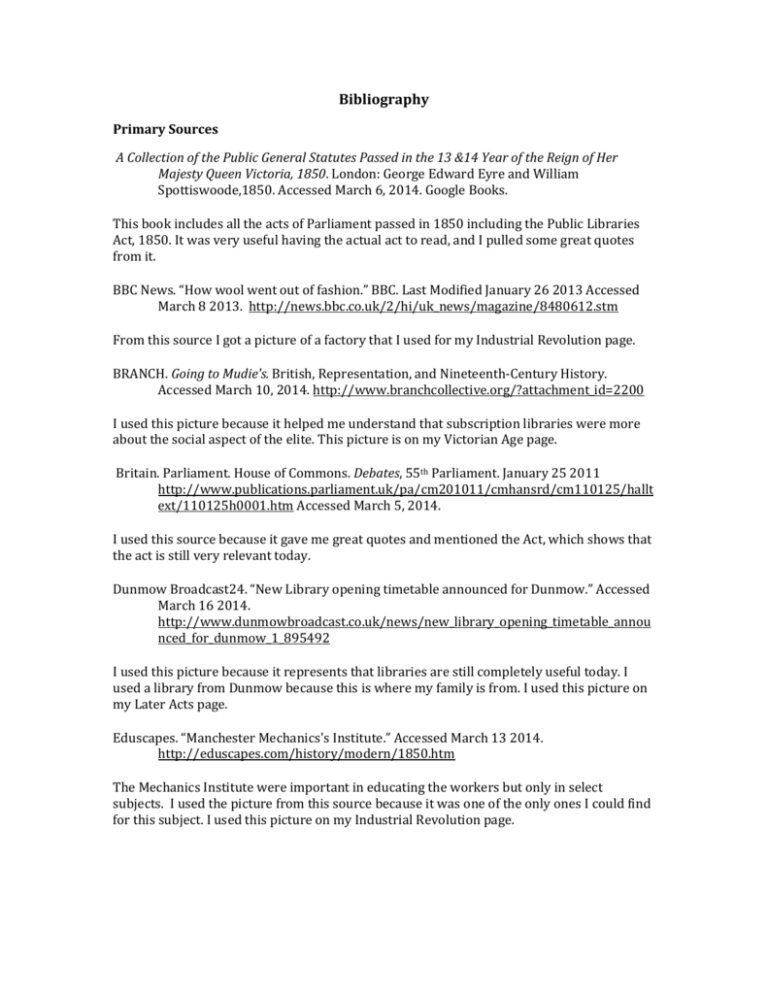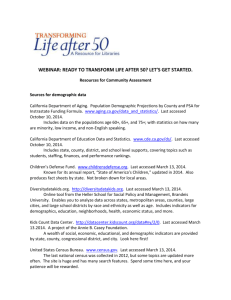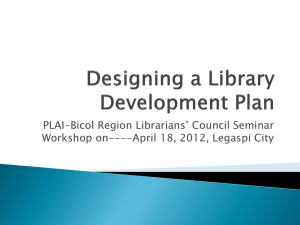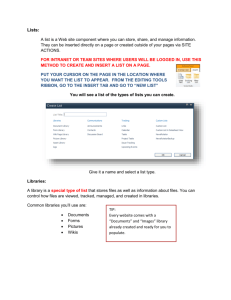Bibliography
advertisement

Bibliography Primary Sources A Collection of the Public General Statutes Passed in the 13 &14 Year of the Reign of Her Majesty Queen Victoria, 1850. London: George Edward Eyre and William Spottiswoode,1850. Accessed March 6, 2014. Google Books. This book includes all the acts of Parliament passed in 1850 including the Public Libraries Act, 1850. It was very useful having the actual act to read, and I pulled some great quotes from it. BBC News. “How wool went out of fashion.” BBC. Last Modified January 26 2013 Accessed March 8 2013. http://news.bbc.co.uk/2/hi/uk_news/magazine/8480612.stm From this source I got a picture of a factory that I used for my Industrial Revolution page. BRANCH. Going to Mudie's. British, Representation, and Nineteenth-Century History. Accessed March 10, 2014. http://www.branchcollective.org/?attachment_id=2200 I used this picture because it helped me understand that subscription libraries were more about the social aspect of the elite. This picture is on my Victorian Age page. Britain. Parliament. House of Commons. Debates, 55th Parliament. January 25 2011 http://www.publications.parliament.uk/pa/cm201011/cmhansrd/cm110125/hallt ext/110125h0001.htm Accessed March 5, 2014. I used this source because it gave me great quotes and mentioned the Act, which shows that the act is still very relevant today. Dunmow Broadcast24. “New Library opening timetable announced for Dunmow.” Accessed March 16 2014. http://www.dunmowbroadcast.co.uk/news/new_library_opening_timetable_annou nced_for_dunmow_1_895492 I used this picture because it represents that libraries are still completely useful today. I used a library from Dunmow because this is where my family is from. I used this picture on my Later Acts page. Eduscapes. “Manchester Mechanics's Institute.” Accessed March 13 2014. http://eduscapes.com/history/modern/1850.htm The Mechanics Institute were important in educating the workers but only in select subjects. I used the picture from this source because it was one of the only ones I could find for this subject. I used this picture on my Industrial Revolution page. Informed Explorer. “Edinburgh.” Accessed March 13 2014. http://informedexplorer.com/2013/12/06/best-places-to-spend-new-years-eve/ This was the prettiest photograph of Edinburg I could find. I used this picture on my Victorian Age page. National Church Library Association Branches Blog. “Westminster Abbey Library” Last modified September 6 2011. Accessed March 13 2014. http://nclabranches.blogspot.com/2011/09/spiritual-literature-on-displayvisit.html I needed a picture of a Parochial library and Westminster is one of the most well known abbeys in England which is why I used this picture. I used this picture on my Victorian Age page. Parliament.uk. “The Lords Chamber.” Accessed March 16, 2014. http://www.parliament.uk/about/livingheritage/building/palace/architecture/palace-s-interiors/lords-chamber/ I used this picture because Parliament is where the whole process of this Act happened so, of course, I needed to represent it somewhere. Also it is a really good picture. I used this picture on my Home page. Reports from the Select Committee on Public Libraries. The House of Commons, 1849. Accessed April 12 2014. Google books. This was a report on the findings of the committee that later passed the Act of 1850. There were many quotes that I used from here and some statistics comparing British public libraries to other European nations. Secondary sources Galgano, Michael. Interview by Mary Larson. Video recording. Harrisonburg, May 16, 2014. I interviewed Dr. Galgano because he is a British History professor at James Madison University. I did not mange to use the whole interview, I only used a couple clips from it, but the whole interview helped me better understand how libraries affected people in Victorian times and even how they still affect us today and into the future. Hammond, Mary. “The Great Fiction Bore: Free Libraries and the Construction of a Reading Public in England.” Libraries & Cultures 37, no. 2 (Spring 2002); 83-108. Accessed March 3 2013. http://www.jstor.org/stable/25548986 I used this source because it provided some great information on the subscription library along with some information on how reading among the elite was more of a show of social superiority. Kelly, Thomas. A History of Adult Education in Great Britain. Liverpool: Liverpool university press, 1992. Libraries were very important in the development of public education. This book gave me some background information on the education of the middle and working classes. It was useful in helping me understand the connections between libraries and public education. Max, Stanley M. “Tory Reaction to the Public Libraries Bill, 1850.” The Journal of Library History 19, no. 4 (Fall 1984); 504-524. Accessed March 3 2014. http://www.jstor.org/stable/25541547 I used this because it gave me the background information` about William Ewart. It also helped me understand how Ewart was connected to education and how the act itself was connected to public education. Minto, John. A History of the Public Library Movement. London: George Allen & Unwin LTD and the Library Association, 1932. This source gave me information on a lot of different types of attempts at public libraries and the people who founded them. Murison, W. J. The Public Library: It’s Origins, Purpose and Significance as a Social Institution. London : G. G. Harrap, 1955. I used this source because it was often quoted by my other sources. It was a really interesting book to read and it helped me better understand my subject as a whole. Sanderson, Michael. Education, Economic Change and Society in England 1780-1870. London and Basingstoke: The Macmillan Press LTD, 1983. This source gave me some statistics that I used on my website. It also supplied me with some background on the Chartist movement. Politics.co.uk. “What are Public Libraries?” Accessed March 15 2013. http://www.politics.co.uk/reference/public-libraries From this website I got some basic information that I needed to start with.







